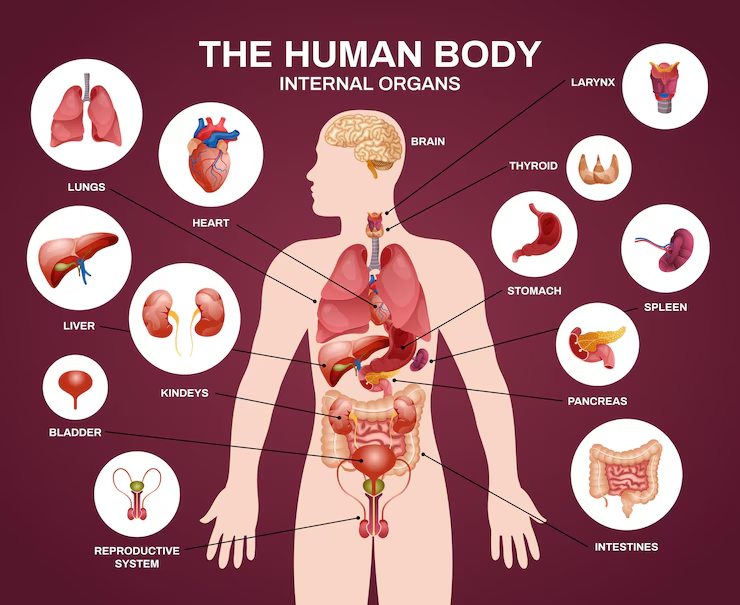Body Parts Name: Learning the names of body parts is one of the first steps in understanding how our bodies work. From the top of your head to the tips of your toes, each part of your body has a special name and function. Let’s explore some common body parts’ names and what they do!
- Head: Your head is where your brain is located, and it’s covered with hair. It includes your eyes, ears, nose, and mouth, which help you see, hear, smell, and eat.
- Shoulders: Below your neck, you have your shoulders. They help you move your arms up and down, side to side, and all around.
- Arms: Your arms are made up of several parts, including the upper arm, elbow, and forearm. They end in your hands, which have fingers for grabbing and touching things.
- Chest: The chest is the upper part of your body. Inside your chest, you’ll find your heart and lungs, which are very important for breathing and pumping blood.
- Stomach: Your stomach is where food goes after you eat it. It’s in the middle part of your body, just below your chest.
- Legs: Legs are strong and help you walk, run, and jump. Each leg includes a thigh, knee, calf, and foot. Feet have toes, which help you balance.
- Feet: Feet is at the bottom of your legs and is what you stand on. They are essential for walking and keeping your balance.
Learning the body parts’ names is not only fun but also essential. Knowing these names helps you understand your body better and communicate any needs or issues you may have to others, such as parents or doctors. The next time you look in the mirror, see if you can name all the body parts you see!
List of 7 Body Parts Names
- 1. The hand is one of the most versatile body parts, consisting of the palm, fingers, and thumb. It allows us to grasp objects, write, and perform intricate tasks with precision.
- 2. The heart is a vital organ that pumps blood throughout the body, providing oxygen and nutrients to every cell. The heart is located in the center of the chest and works tirelessly to maintain our overall health and well-being.
- 3. The foot is a complex structure that supports our body weight and allows us to walk, run, and jump. It consists of bones, muscles, and ligaments that work together to provide stability and mobility. Our feet play a crucial role in our daily activities and require proper care to prevent injuries and maintain overall health.
Explore All Body Parts Names with Pictures
The human body consists of many different parts, each with its unique function. Some of the major body parts include the head, neck, arms, hands, legs, and feet. These parts are essential for carrying out various activities such as walking, running, eating, and speaking. Additionally, the torso includes the chest, abdomen, and back, which house vital organs like the heart, lungs, and liver.
It is important to have a basic understanding of the names and functions of all body parts to ensure overall health and well-being. For example, knowing the names of different bones, muscles, and organs can help in identifying and addressing any issues or injuries that may arise. It is also beneficial for effective communication with healthcare professionals when seeking medical treatment or advice.
With advancements in technology, it has become easier to explore and learn about all body parts through detailed anatomical diagrams, virtual reality simulations, and interactive learning tools. These resources provide a comprehensive and visual representation of the human body, making it easier to understand the complex systems that keep us healthy and functioning. By familiarizing ourselves with all body parts, we can better appreciate the intricacies of our bodies and take steps toward maintaining optimal health.
अंगों के नाम: Angon Ke Naam in Hindi
अंगों के नाम व्यक्ति के शरीर के विभिन्न भागों को संदर्भित करने के लिए प्रयोग में आने वाले होते हैं। इनमें हाथ, पैर, मुंह, नाक, आँखें, और कान जैसे अंग शामिल हो सकते हैं। हर एक अंग का अपना विशिष्ट कार्य होता है और संपूर्ण शरीर के साथ मिलकर कार्य करने में मूलभूत महत्व होता है।
हिंदी में व्यक्ति के अंगों के लिए अक्सर उनके वैज्ञानिक नामों का इस्तेमाल होता है। जैसे, हाथ को हस्त, पैर को पाद, मुंह को मुख, और नाक को नासिका कहते हैं। इन नामों का ज्ञान होना शरीर के रोगों और आवाजाहीनता जैसी समस्याओं को समझने में मदद कर सकता है।
Discover the Names of Human Internal Body Parts
Some of the main internal body parts include the heart, lungs, kidneys, liver, and stomach. These organs play vital roles in keeping the body functioning properly. The heart, for example, pumps blood throughout the body and supplies oxygen and nutrients to the cells.
Other important internal body parts include the brain, which serves as the body’s control center, coordinating all bodily functions and processes. The intestines, which are part of the digestive system, absorb nutrients from food and eliminate waste. Understanding the names and functions of these internal body parts is important for maintaining overall health and well-being.
Learn the Names of Different Parts of the Body Leg
The leg is a complex structure of the body that plays a vital role in movement and support. The main parts of the leg include the thigh, the lower leg, and the foot. It is responsible for providing support and facilitating the movement of the leg.
It is essential to take care of the leg and maintain its health through proper exercise, nutrition, and rest to ensure optimal functioning and prevent injuries. Understanding the different parts of the leg and their functions can help individuals appreciate the complexity and importance of this remarkable structure.
Fingers Name: Understanding the Five Digits
Our hands are incredible tools that allow us to interact with the world in countless ways. Each of our fingers has a specific name and function, contributing to the versatility and dexterity of our hands. Knowing the “fingers’ name” helps us appreciate the role each digit plays.
- Thumb (Pollex): The thumb is the most versatile of the fingers. Its unique movement capability is what sets humans apart from many other species.
- Index Finger (Forefinger or Pointer): The index finger is often used for pointing, hence the name “pointer.” It’s also the most sensitive finger, used frequently for tasks that require precision, such as typing or pressing buttons.
- Middle Finger (Long Finger): The middle finger is the longest of the fingers, located centrally on the hand.
- Ring Finger (Annular): Traditionally, the ring finger is known for being the digit where engagement and wedding rings are worn. It is slightly weaker than the other fingers, but it works in coordination with the pinky for grip strength.
- Little Finger (Pinky): The pinky may be the smallest finger, but it plays an important role in hand function. It provides support and balance to the hand, especially in grip and power tasks.
Understanding the “fingers’ name” enhances our appreciation of the complex and coordinated actions our hands perform daily.
How Can Droughts be Triggered by Human Activities?
Human activities can significantly trigger droughts by altering natural processes. Deforestation, for example, reduces the number of trees that help retain moisture in the atmosphere, leading to drier conditions. Overuse of water resources for agriculture and industry depletes water supplies, worsening drought conditions. Additionally, urbanization paves over land, reducing groundwater recharge. Human-induced climate change is also a major factor, as increased greenhouse gas emissions raise temperatures and disrupt weather patterns. These activities contribute to more frequent and intense droughts, affecting ecosystems and human livelihoods. Understanding how droughts can be triggered by human activities is vital for developing sustainable solutions.






[…] Discover the Human Internal Body Parts Name […]